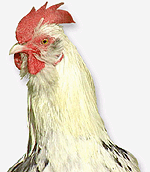Faverolle Chooks
Breed: Faverolle
Temperament: Placid
Cost: Around $50, more for quality breeding stock.
Lifespan: 5-7 years
Recommended for: Backyarders
Appearance
The Faverolle is a deep chested bird with a thick rectangular body and an unusual owl-like feathered face. They have small ear-lobes and wattles partly concealed by the muffling, and a long full beard. The breed is polydactyl, with an extra toe positioned above the fourth, and the legs are sparsely feathered down to the outer toe. Salmon is the most popular colour, but they also come in black, blue, buff, ermine and white.
Roosters weigh 3.5-4.5kg (8-10lb) and hens 3-4kg (6.5-8.5lb). Faverolle bantams are exact replicas of their large fowl counterparts. Males weigh 1130-1360g (40-48oz) and females 910-1130g (32-40oz).
Temperament
Faverolles are quiet, placid and easily handled. Aggression is rarely seen, even in the males. Docile Faverolle chicks are often bullied if they are raised with other more aggressive breeds. Broodiness is also a characteristic of the breed.
Health & lifespan
Breeders say that Faverolles are strong hardy birds which pretty much look after themselves, apart from normal chook husbandry and vaccinations against Mareks disease.
Feeding
Annette Bryant recommends a mixture of layer crumble and coarse mash which includes grain, calcium and vitamins, along with grass, clean water and kitchen scraps.
Breeding & costs
The hens are persistent sitters – they are easy to handle and the chicks grow up quiet and trusting. Fertility is generally high. Chicks are strong and fast growing. Faverolles usually cost about $50 each.
Uses
Faverolles are excellent table birds. Their meat is white, with good grain and flavour. They are also very good layers, and produce about 150 eggs per laying season. Annette Bryant estimates three birds would be ample to supply a family with eggs.
Space & housing requirements
Faverolles need semi-intensive shedding during winter to protect their face and foot furnishings from rain and mud. All fowls should be penned at night to avoid predators, such as cats and foxes. It is essential to check with your local council regarding regulations for keeping poultry. Some councils will allow poultry but have rules which mean it’s unlikely suburban homeowners could comply. For example, a chook pen may be permissible as long as it is sited a minimum of 18m (60′) from any fixed structure, including fences.
History
The breed had its origins in the Eure et Loir area of northern France and was named after the village of Faverolle. Originally it was developed as a dual purpose breed, producing heavy table fowls and winter layers of tinted eggs. Faverolles were first imported to Australia in the 1920s by a Madame Masseran. Her husband was a chef at the Melbourne Club and she saw the chance to meet the exclusive tastes of the club’s patrons by providing the sought after flesh of the Faverolles.
Further information
NSW:
Annette Bryant
Bantam Buddies
Phone: (02) 9653 1305
City of Parramatta & Districts Poultry Society
Bob Watts
Phone: (02) 4577 5157
VIC:
Victorian Poultry Fanciers Association
Ian Pollerd
Phone: (03) 5446 9211
QLD:
Feather Club’s Association of Queensland
Owen Glover
Phone: (07) 3888 3538
WA:
Exhibition Poultry Breeder’s Council of WA
Ian Hancock
Phone: (08) 9574 1354
SA:
South Australian Poultry Association
Tom Bowden
Phone: (08) 8383 0009
TAS:
Tasmanian Poultry Fanciers Association
Breeder: Denis Lyne
Phone: (03) 6362 2920



